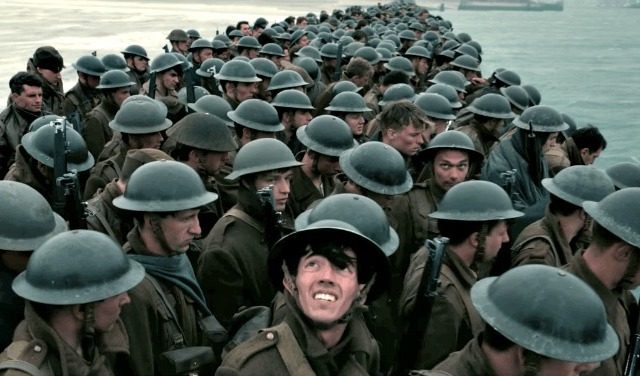
With “Dunkirk,” writer-director Christopher Nolan, most famous for his Batman trilogy but even better at mind-benders like “Memento” and “Inception,” applies his cerebral skillset to another familiar genre: the World War II movie. Rather than turn the true story into a puzzle, Nolan keeps the plot simple and delivers an intense, carefully calibrated mini-epic about surviving war. But he puts his own spin on it, too, breaking the story into three separate overlapping narratives. It is every inch a Christopher Nolan War Movie.
The situation, as you no doubt recall from history class or from falling asleep watching The History Channel, is this. It’s late May 1940, and nearly 400,000 British and French troops are trapped by the Germans on the beaches of Dunkirk, France, waiting to be evacuated. But the massive ships that can carry many soldiers are too heavy to get close to shore (or too heavy to leave again once they do, I suppose), so the anxious troops must wait several days for a flotilla of smaller boats, in the meantime almost defenseless against the German dive-bombers that come around now and then to shoot them like fish in a barrel.
Onscreen titles tell us the film’s structure. Part 1, set on the beach (or the “mole,” referring to the stone piers that form the harbor), occupies a week of time. Part 2, set on the sea and following the efforts of a British civilian named Dawson (Mark Rylance) to sail his yacht across the English Channel to assist in the evacuation, takes place on the last day of that week. Part 3, with Royal Air Force pilot Farrier (Tom Hardy) coming in to provide cover, spans an hour of that last day. So it’s only the last bit of the story where all three converge, but Nolan, with his God-like view of time, alternates between sections as if they were happening simultaneously. The benefit of this is that it lets the people in Parts 2 and 3 be major characters in the film, not just saviors who arrive in the last few minutes.
Whether on land, sea, or in the air, there is peril to be found at every moment. On the beach, we follow soldier boys named Tommy (Fionn Whitehead) and Gibson (Aneurin Barnard) as they scramble from one hiding place to the next (under the pier, inside an abandoned trawler, etc.). Representing the mass of troops, these and a few other young men (including one played by Harry Styles) are in a near-constant state of panic, which Nolan gooses by having the Germans strafe the beach periodically in ominous, terror-inducing strikes.
Out in the Channel, Dawson, his teenage son Peter (Tom Glynn-Carney), and Peter’s friend George (Barry Keoghan) pick up a shellshocked British soldier (Cillian Murphy) whose vessel was sunk by a U-boat and who is now strongly opposed to the idea of going back to Dunkirk. In the air, Farrier fights German planes while seeing his fellow fliers picked off one by one. In all three scenarios, there is a high incidence of being rescued from metaphorical frying pans only to be dropped into metaphorical (and in one case literal) fires. By telling all three parts at once, Nolan keeps the story from building to a climax in the customary way. Instead, the movie feels like one slow, sustained climax, urged onward by Hans Zimmer’s tick-tock musical score, with nothing to indicate how much further we have to go. It often feels like a bad dream that could end momentarily or last forever.
For as expansive as the visuals often are (gorgeously shot by cinematographer Hoyte Van Hoytema), Nolan is more measured when it comes to the emotional beats. That’s where “Dunkirk” sneaks up on you. Despite barely knowing any characters’ names or seeing much to distinguish them from one another, we’re moved by their plight and stirred by their eventual rescue. There are officers, of course (including Kenneth Branagh), but most of the 400,000 are practically kids who have done their best, lost the battle, and now just want to go home. For them, surviving is a victory in itself. The film isn’t as viscerally harrowing as some war movies, but thanks to Nolan’s precision and the work of editor Lee Smith, it packs the punch of something far more graphic.
(Trivia: “Dunkirk” is also the phonetic spelling of the “Law & Order” sound.)
B+ (1 hr., 46 min.; )





